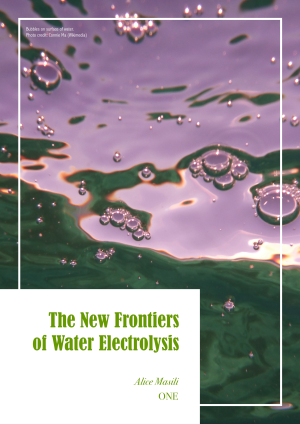 The sustainable and economical production of hydrogen, particularly “green” hydrogen, is crucial for the decarbonisation of industry and the transport sector, and the electrolysis process could be the key to achieving this. The history of electrolysis is not new, but rather an evolving journey that began in the 18th century and has led to today’s technologies revolutionising energy production methods.
The sustainable and economical production of hydrogen, particularly “green” hydrogen, is crucial for the decarbonisation of industry and the transport sector, and the electrolysis process could be the key to achieving this. The history of electrolysis is not new, but rather an evolving journey that began in the 18th century and has led to today’s technologies revolutionising energy production methods.
What is electrolysis, and how does it work? The flow of electricity through liquids sometimes results in chemical changes. Consider a circuit consisting of a generator, a light bulb and two metal rods submerged in a fluid with generator poles connected to them. If the liquid is distilled water, the light bulb will stay off. If, instead, salt, an acid, or an alkaline substance is added to the water, the light bulb switches on. This means that water does not conduct electricity unless it is present in the solution with substances called electrolytes. The metal rods, called electrodes, connected to the poles of the generator are electrically charged. The anode is the positively charged electrode, while the cathode is the negatively charged one. The salt in solution separates into positive ions (cations) and negative ions (anions) due to the attraction of the electrodes. The cations migrate towards the cathode, while the anions are attracted to the anode. This process is known as electrolysis.
The entire system is referred to as an electrolytic cell.
Although the phenomenon of electrolysis is already described in some writings from the 5th century AD, it was not until the invention of the Volta battery that the first real electrolysis of water and its splitting into hydrogen and oxygen was achieved. After all, it was Faraday who laid the foundations of modern electrochemistry with his famous laws and defined the terms “electrode”, “anode”, “cathode”, “ion”, and “electrolyte” that we still use today.
For a long time, alkaline electrolysis dominated large-scale hydrogen production for the chemical industry until the growing awareness of the climate crisis made hydrogen production a central element of decarbonisation. It was no longer enough to produce it; it also had to be generated sustainably using renewable energies. This marked a new chapter of electrolysis, with the emergence of technologies that still pose a challenge today.
The current impetus for the energy transition is propelling scientists and engineers to design, refine, and bring to market new generations of electrolysers. Competing for the most efficient, scalable and economical green hydrogen production, several advanced electrolysis methods offer distinct advantages.
Proton exchange membrane electrolysis (PEMEL), for example, uses the properties of a solid polymer membrane (PEM) as the electrolyte and is particularly valued for its ability to start, stop and modulate the production of hydrogen quickly. This makes them ideal for direct coupling with intermittent renewable energy sources such as wind and solar to maximise the use of renewable energy and stabilise the grid. BASF recently utilised this type of electrolysis in the commissioning of Germany’s largest proton-exchange membrane (PEM) electrolyser. The 54 MW plant, built in collaboration with Siemens Energy, can produce up to 8,000 tons of green hydrogen per year. This has the potential to reduce hydrogen emissions at BASF’s primary facility by up to 72,000 tons annually. Green hydrogen is utilised, among other things, in the synthesis of ammonia and methanol. Some of it will be fed into the site’s H2 network and then distributed to the heavy industry and mobility sectors in the Rhine-Neckar metropolitan region.
High-temperature electrolysis (SOEC: Solid Oxide Electrolyser Cells) typically operates between 600°C and 800°C, utilising a solid ceramic electrolyte. Some of the energy required for water splitting can be supplied in the form of heat, for example, by using waste heat from industrial processes (such as steelworks and chemical plants) or energy sources like nuclear power or concentrated solar power. SOECs can achieve very high conversion efficiencies, in some cases reaching up to 100%. One of the largest solid oxide electrolysers has been successfully installed at the Neste biofuel refinery in the port of Rotterdam (Netherlands). The 2.6 MW system, consisting of 12 electrolysis modules, uses the waste heat from the refinery to reach an operating temperature of 850 °C by converting steam into hydrogen.
Anion exchange membrane electrolysis (AEM) combines low cost and high flexibility with the advantages of other electrolysis technologies, using a solid anion exchange membrane as the electrolyte. As it is a less mature technology, research is focusing on the development of stable and highly conductive AEM membranes, which should ensure a longer lifetime of the electrolyser and large-scale scalability up to commercialisation. The German company Enapter is a pioneer in the commercialisation of AEM electrolysers. Their AEM modules have been implemented in several pilot projects around the world, from hydrogen generation for small, renewable energy-powered microgrids (such as Phi Suea House in Thailand) to integration into hydrogen refuelling stations for vehicles and small industrial applications.
Decoupled electrolysis is also a promising development in water electrolysis. The separation of the anodic and cathodic environments offers the possibility of optimising operating conditions, improving the purity of the gases produced and potentially reducing costs by using less noble materials. Although further research and development are needed to overcome the current challenges, this technology could play a crucial role in the production of green hydrogen for a sustainable energy future.
These technologies are breaking new ground in efficiency, flexibility, and cost-effectiveness, each with its special perks. Furthermore, innovative concepts like decoupled electrolysis are paving the way for even more efficient and affordable production techniques. While there are still some research and development challenges to tackle, these innovations emphasise the essential role of water electrolysis in crafting a sustainable and clean energy future, all wrapped up in the promise of green hydrogen.
Alice Masili




